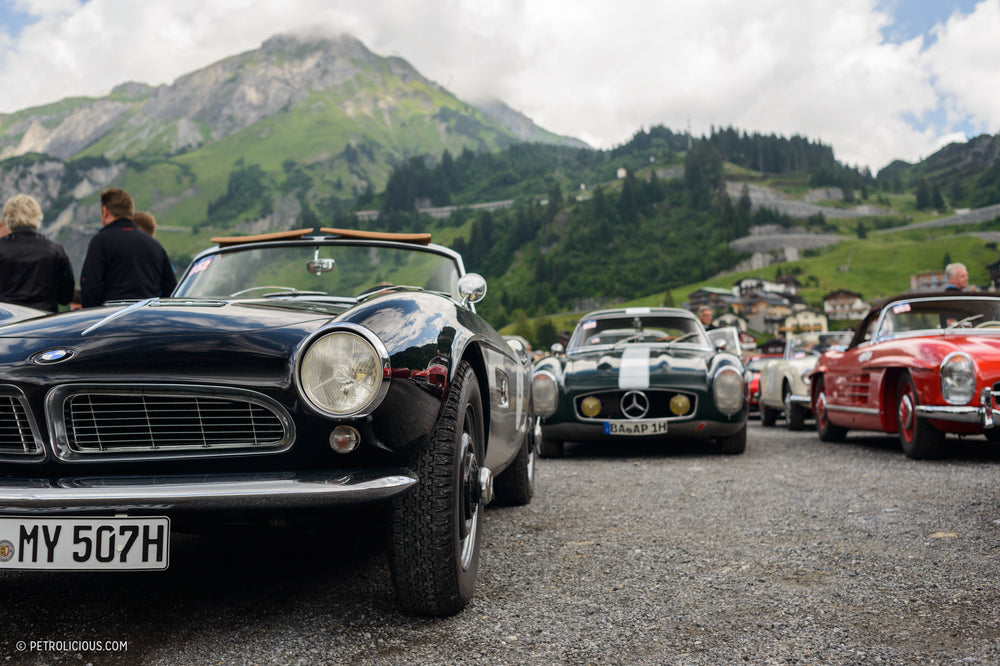The Silvretta Classic, arguably one of the most fun classic car rallies in Europe, is a 650- kilometer-long journey through the Alps. This year the rally started for the 21st time, and we joined the pack of the 180 participants onboard a little 1971 NSU 1000C to tackle the mountain passes for the three-day event.








Right after the start in Partenen, an Austrian mountain village, we headed to the pass from where the rally takes its name: the Silvretta High Alpine Road. This scenic road goes up to the Bielerhöhe pass at 2,032 meters above sea level, and in the upper elevation thick clouds and pouring rain hid the view from us this time. These circumstances made the hillclimb even more exciting though, with its 34 mostly guardrail-free hairpin turns urging just a bit more caution with the low visibility. There were about a dozen pre-war machines in front of the field leading the mostly blind way, for the older your car, the earlier you started. This also meant we met face to face with them on their descent back to the valley from the Bielerhöhe.





It was a great sight to watch the big Bentleys materializing in the fog, throwing water high up in the air from their skinny treads as they rumbled down the hill in low gear. Our favorite car, a custom-built 1930 Ford Model A Boattail didn’t even had fenders, so it didn’t take long until its passengers and the car itself got completely soaked and dirty. Magnus Walker’s motto, “Dirt don’t slow you down” was fitting here, and the Urban Outlaw was there in person to demonstrate it. He drove a 300 SL Gullwing with Hannah Elliott on the Silvretta Classic this year, and I couldn’t believe my eyes, meeting them in a small village o this side of the earth.








On the second day, we went out for a 370-kilometer-long stage and discovered some parts of Lichtenstein and Switzerland. For the first time ever in the rally’s history, the participants conquered the famous Albula Pass in the Swiss canton of Graubünden. For the second day the starting order was changed slightly in accordance with the previous day’s results: the top 20 teams jumped in front, including us on the 16th position. It meant that the 4-8L prewar machines started a few minutes after us, and we didn’t have to wait too long until they appeared in the rearview mirror.
Although Formula 1 star and Le Mans-winner Jochen Mass’s 1928 Mercedes-Benz SSK wasn’t the oldest car in the rally, it received starting number “1” to celebrate the 90th anniversary of the supercharged Mercedes race cars. The White Elephants, the nickname of the huge, white-painted S, SS, SSK, and SSKL models, represent a milestone in motorsport history. In 1927 Rudolf Caracciola won the Nürburgring’s opening race with a Type-S, and it was just the beginning of the successes of the supercharged steeds from Stuttgart, among those Mille Miglia and Monaco GP victories. Mercedes-Benz Classic, the rally’s premier sponsor, brought the 7.1L, six-cylinder, 225 HP SSK to Austria. The supercharger’s whistling is still in my ears days later.


There were other interesting cars on the starting grid of course, especially seeing as BMW Classic brought four M1s to Austria, and in addition to them two 507s and a “Glas” 1600 GT really spiced up the Bavarian fleet. There was a 1927 Chrysler Imperial, actually an Argentinean-made race car powered by a straight-eight Chrysler engine. It is one of the four examples ever made according to its proud owner. It was a delight to see a factory original Fiat Abarth 131 Stradale on the other side of the spectrum, a real rarity nowadays. Just 400 examples were produced to meet the homologation rules, and today only 23 Stradale models are left. This example is still with its first owner who keeps it in a wonderful, well-preserved state.









The long second day left its marks on our little NSU. First the speedo cable broke and we not only lost indication of speed, but more importantly the Tripmaster stopped working. Electronic devices were no option, for this year only mechanical measuring was allowed on the Silvretta Classic, a new rule which I very much agree with. Classic cars are not meant to be driven like modern ones, so why not use period-correct instruments too? Shortly after the speedo left us, the windshield wiper died too and the rain just wouldn’t stop. Those issues are inevitable in classic car racing, but none of these explain our bad results on the second and third days!



The last day finally showed us what summer looks like in the Montafon Valley as the sky cleared and our parade gleamed in the sun. Most of the day we drove up and down the surrounding mountains, among them the Silvretta pass again, but this time from the other side. These rallies are focusing on the driving experience of course, but the cultural and gastronomical treats make it worthwhile for other reasons. Both the first day’s opening dinner and the gala dinner were held high up in the mountains, where the participants arrived on ski lifts. A well-chosen bit of scenery for the first class service.
With the 37th place overall we didn’t achieve the result we expected, but with such great people in this environment with all these beautiful cars, one must ask: does it really matter?































































